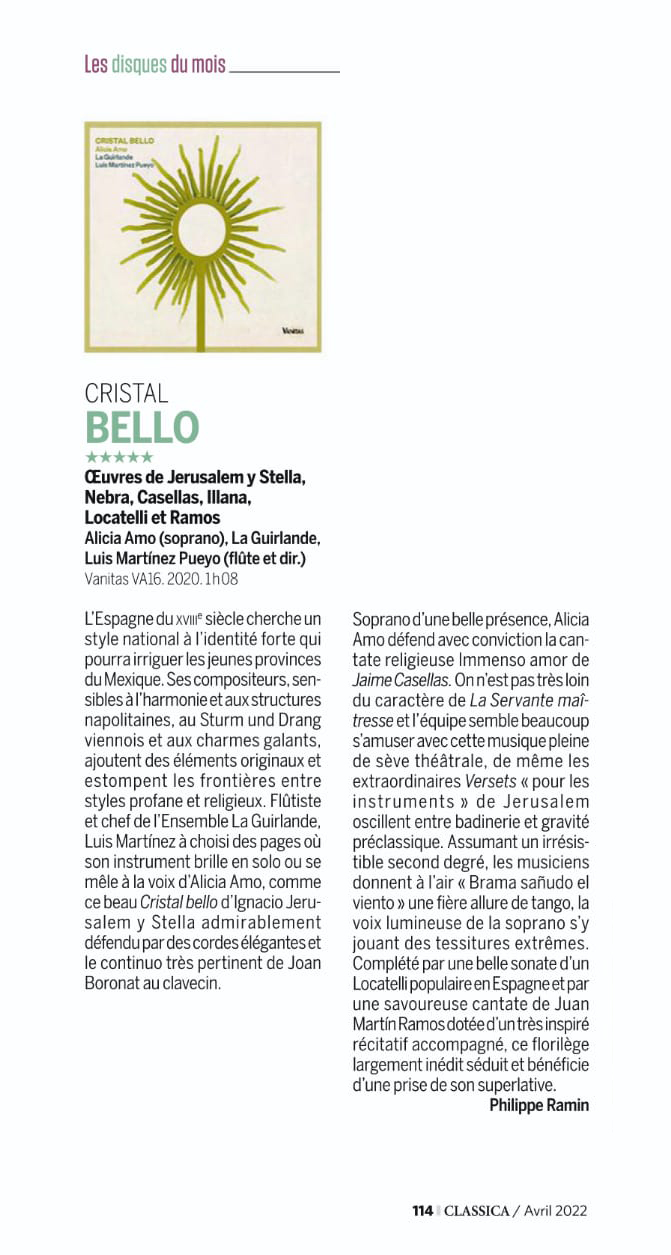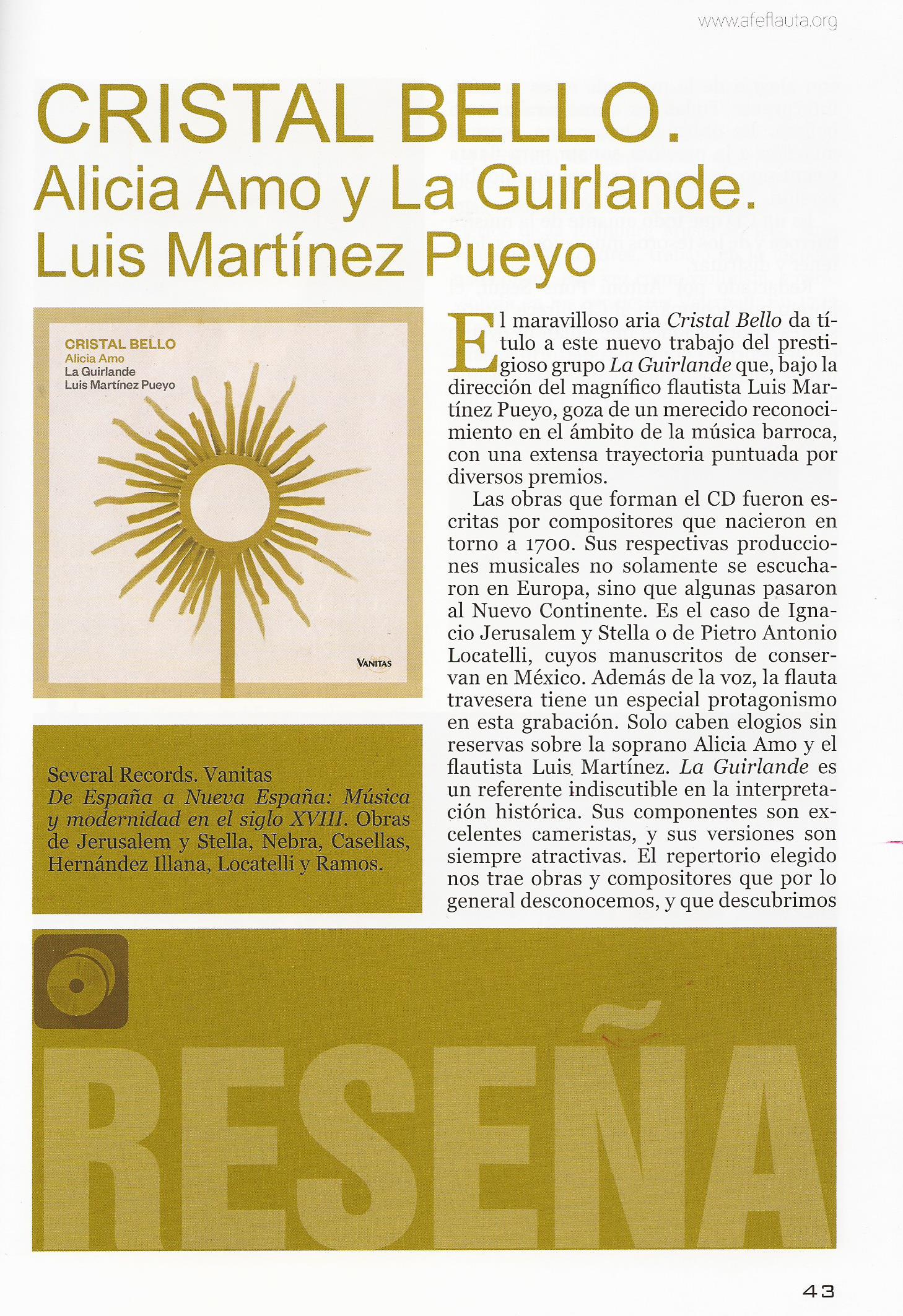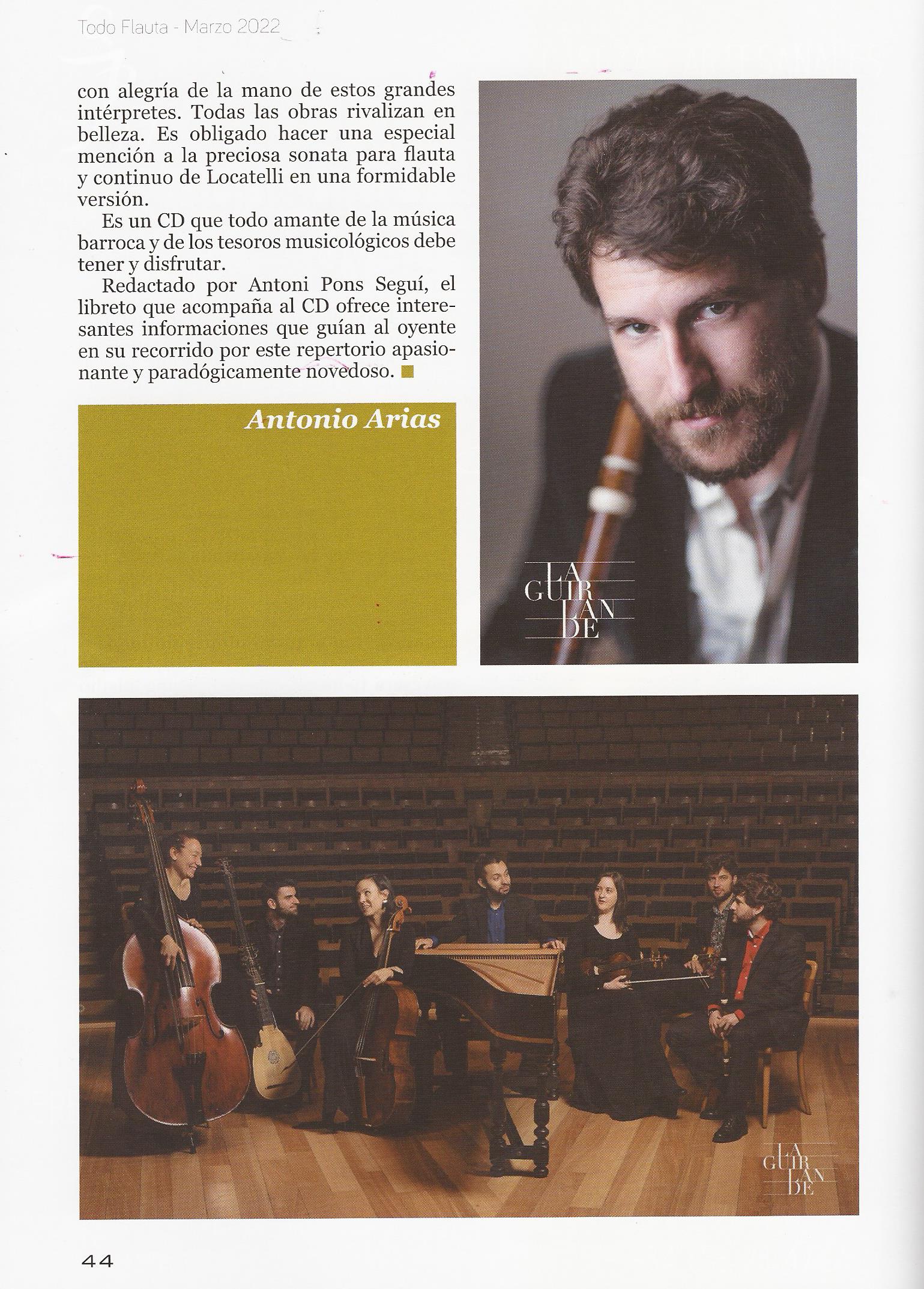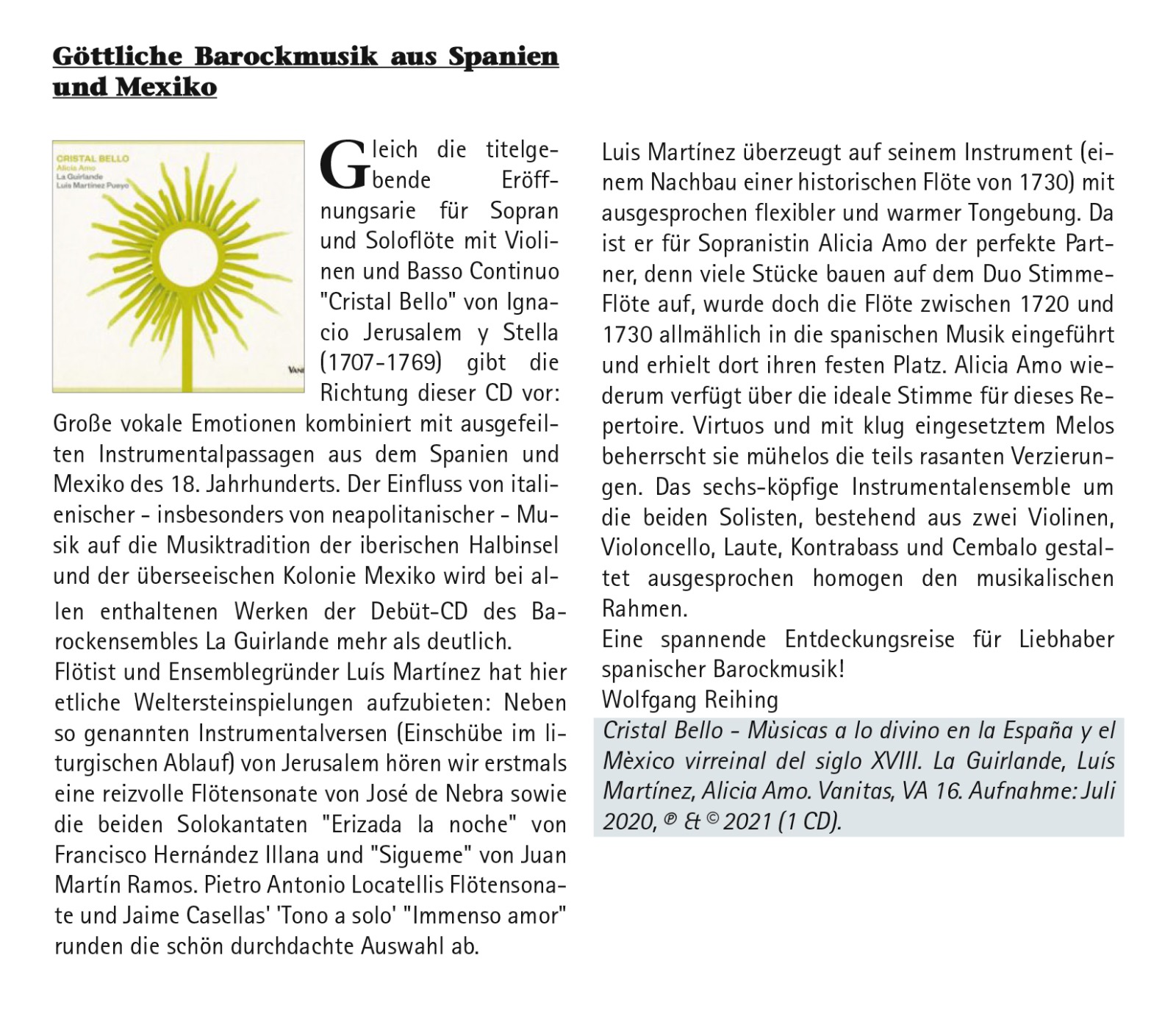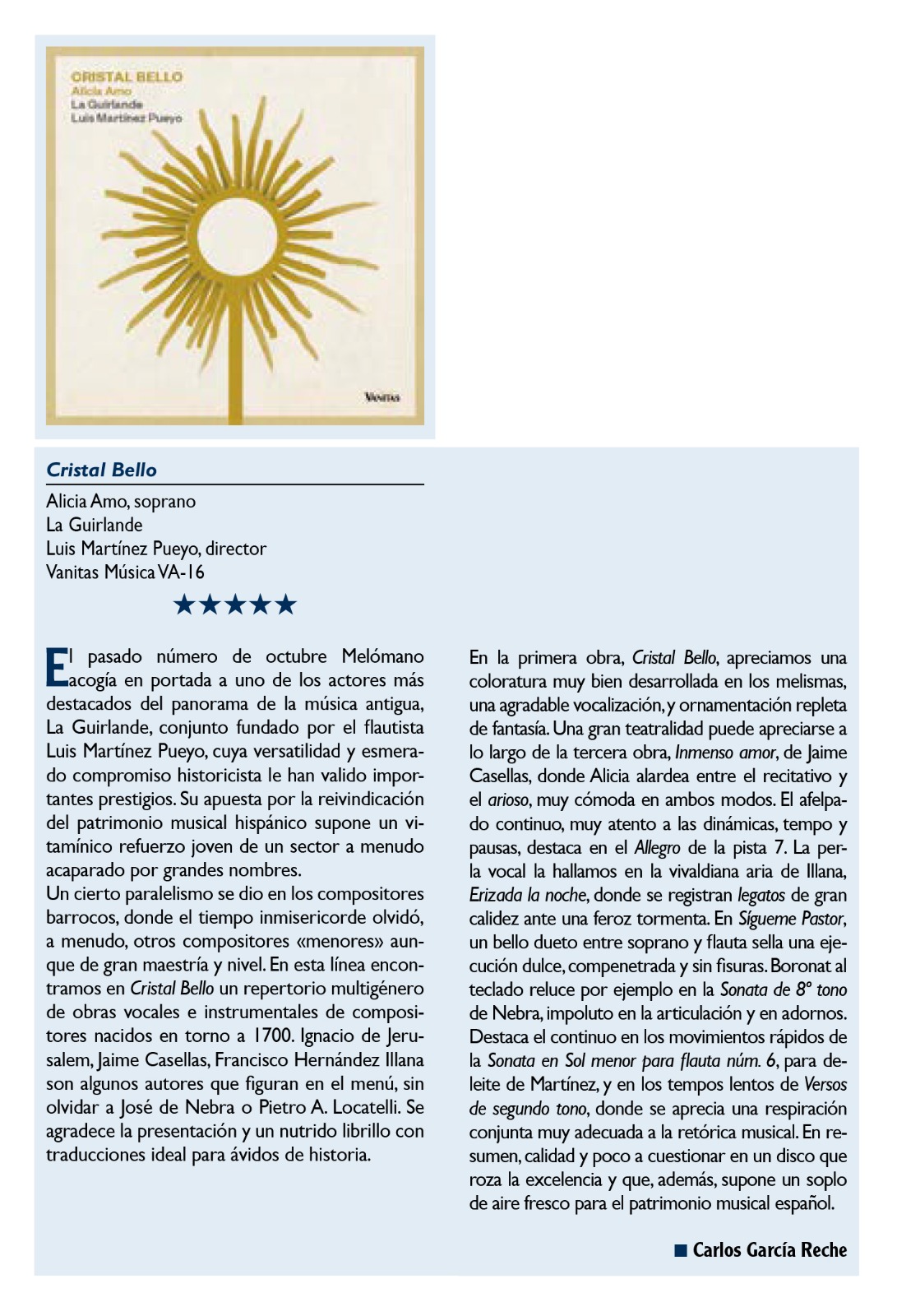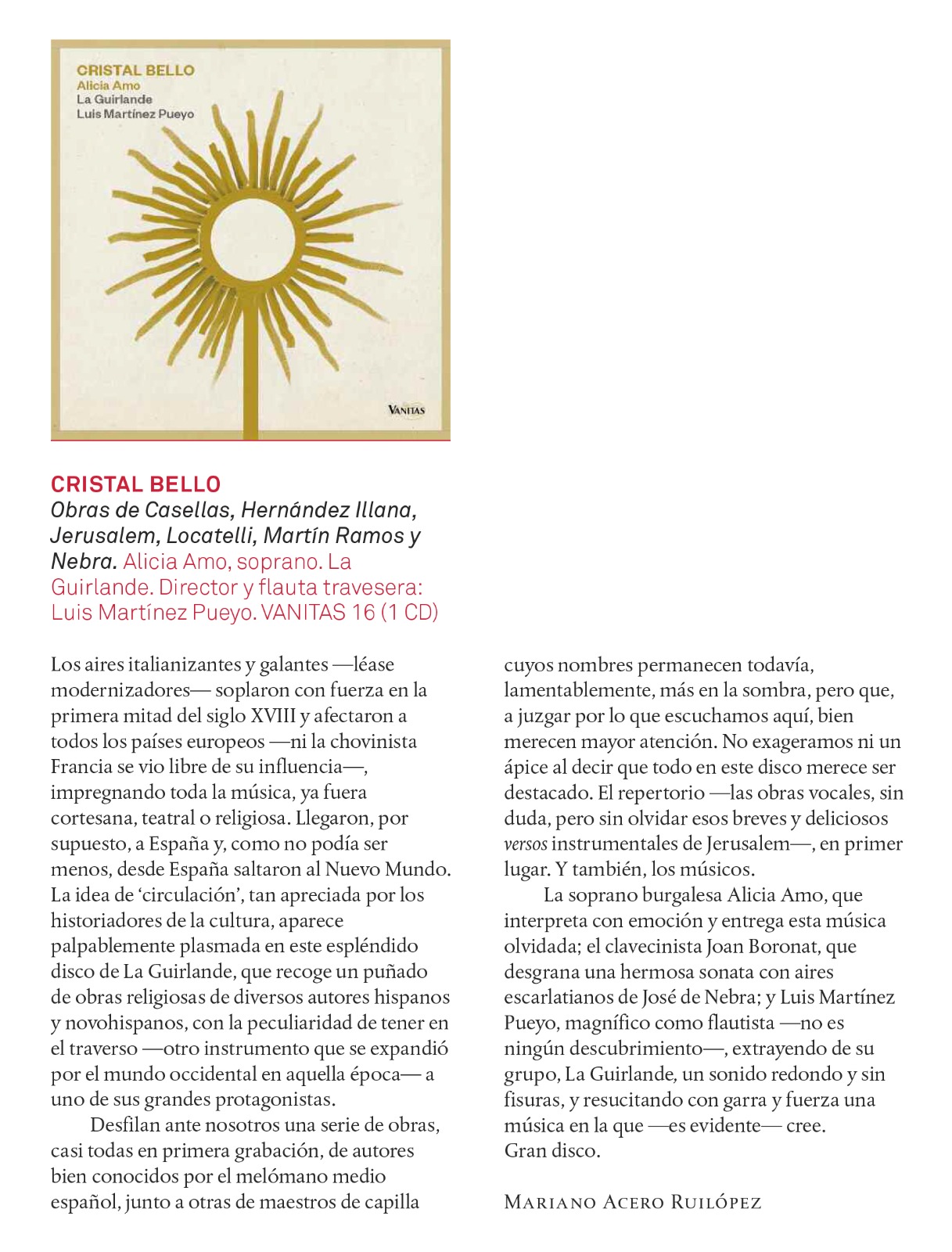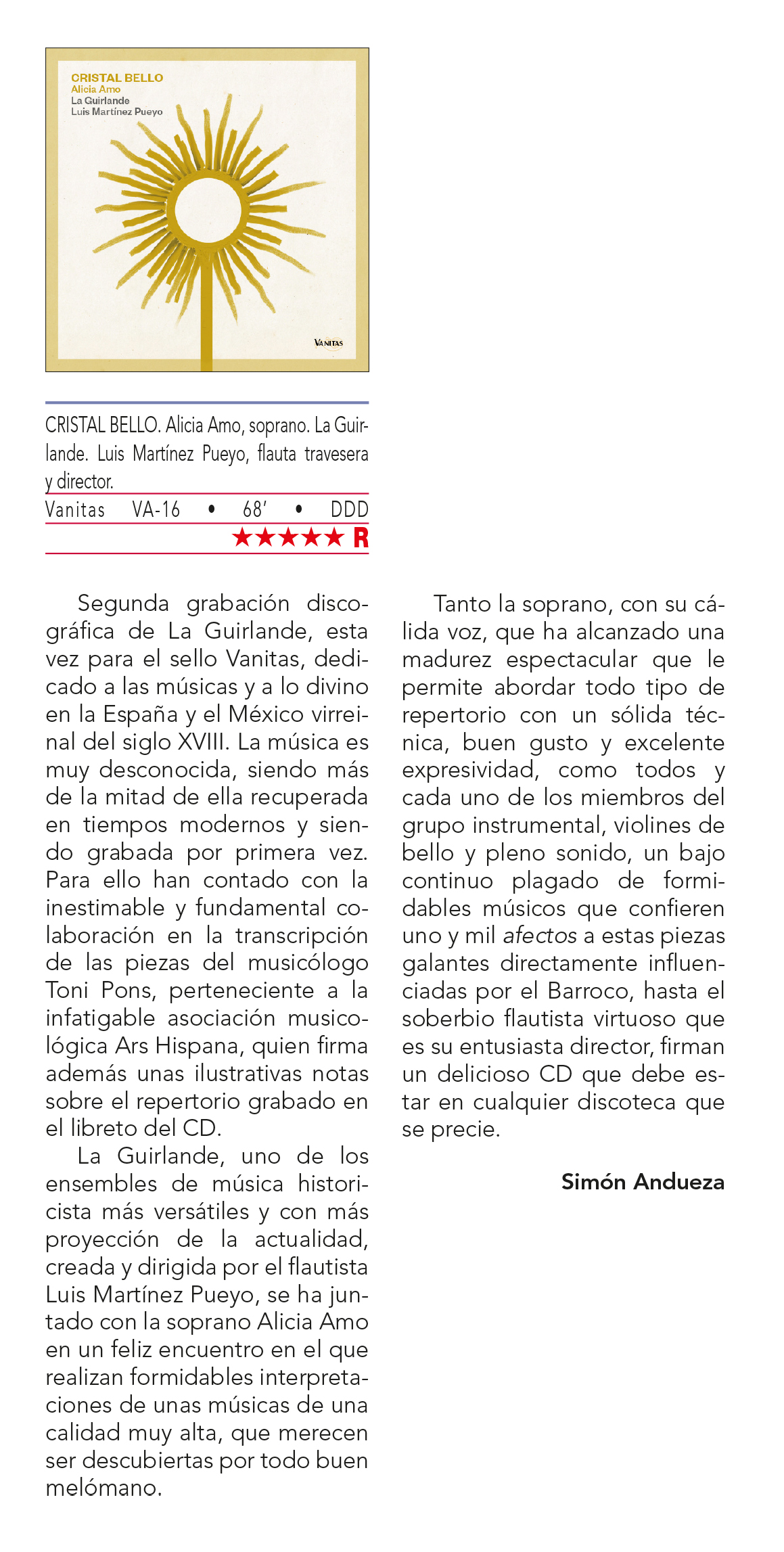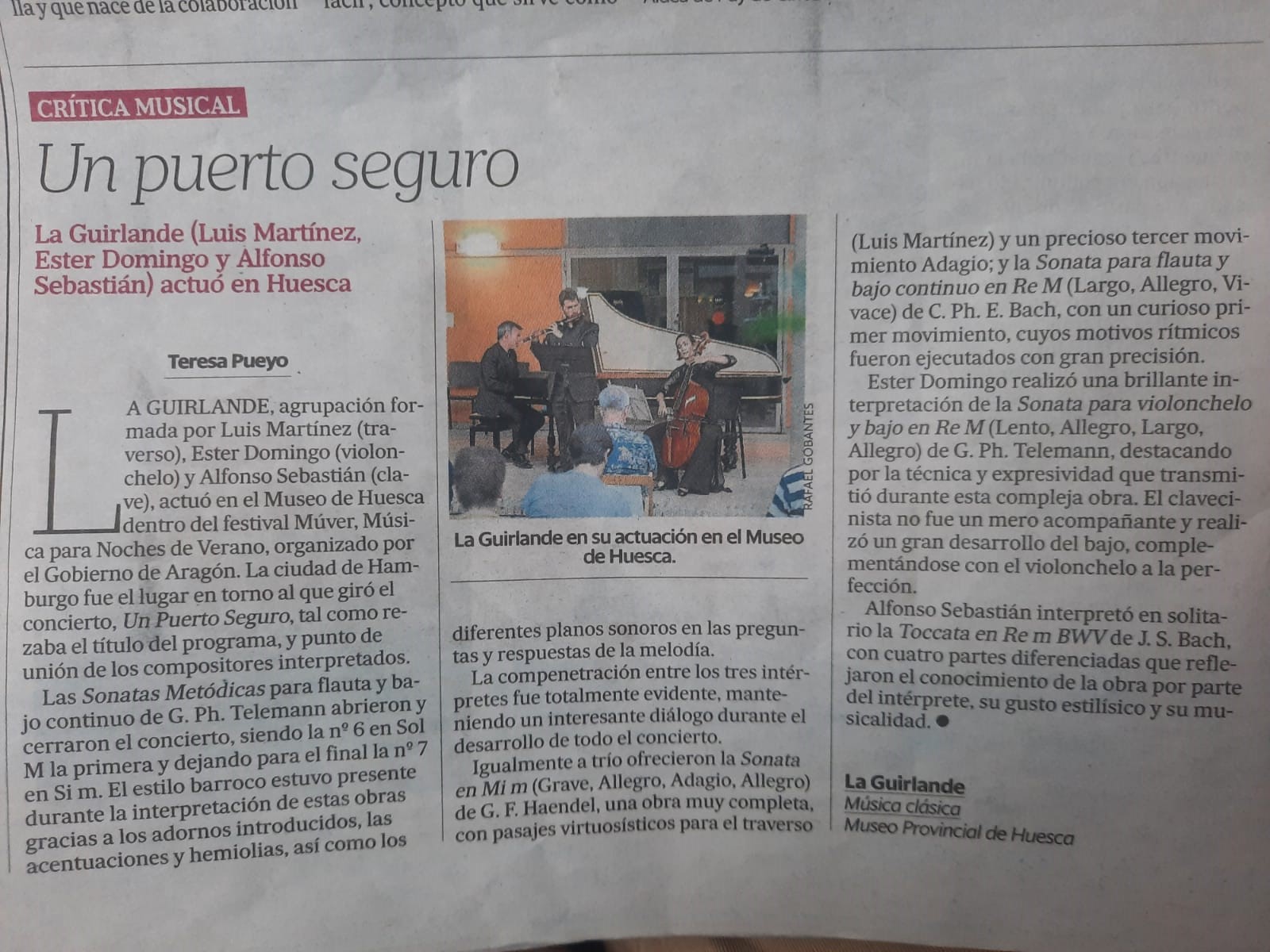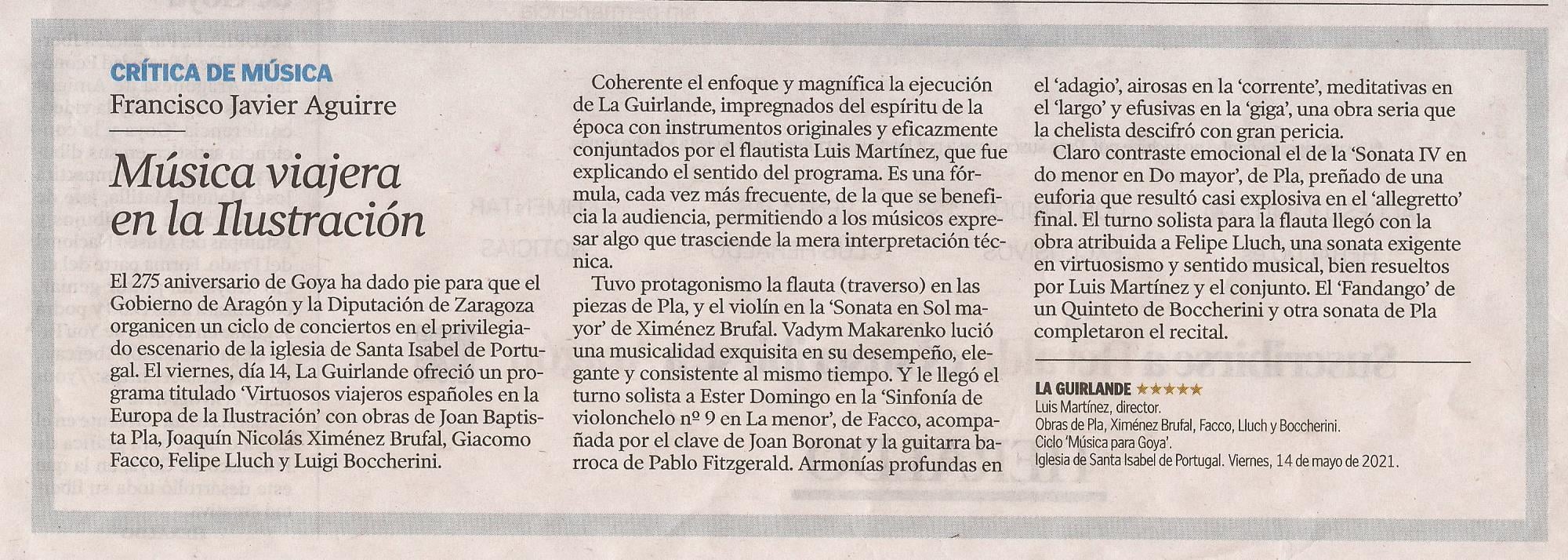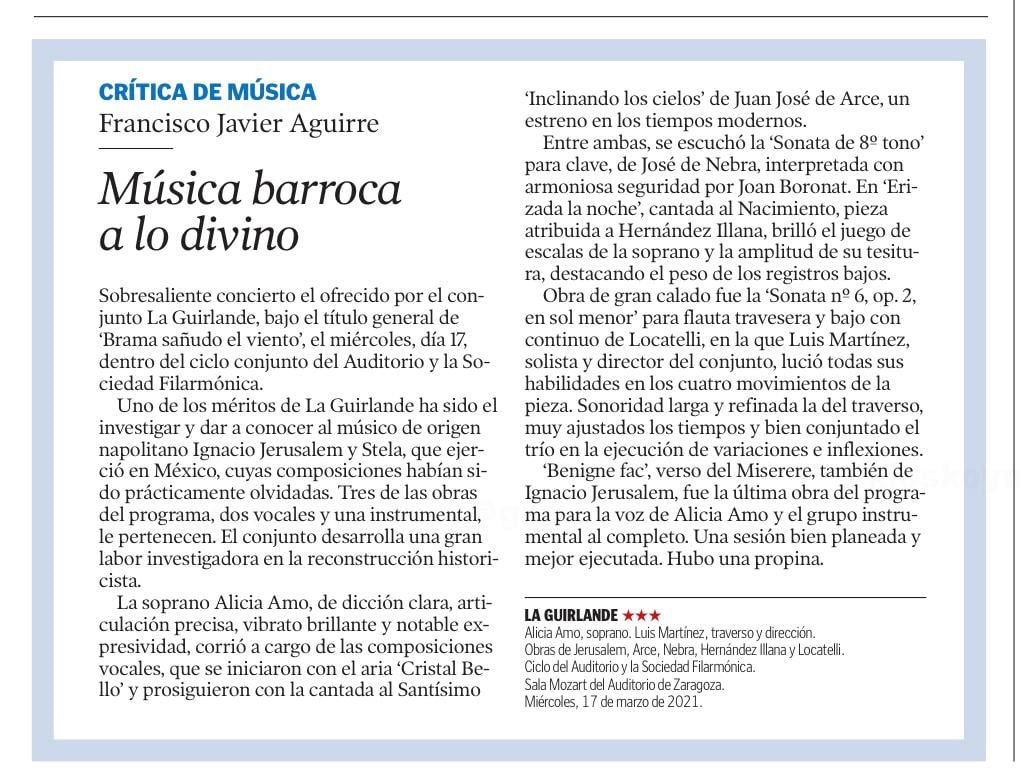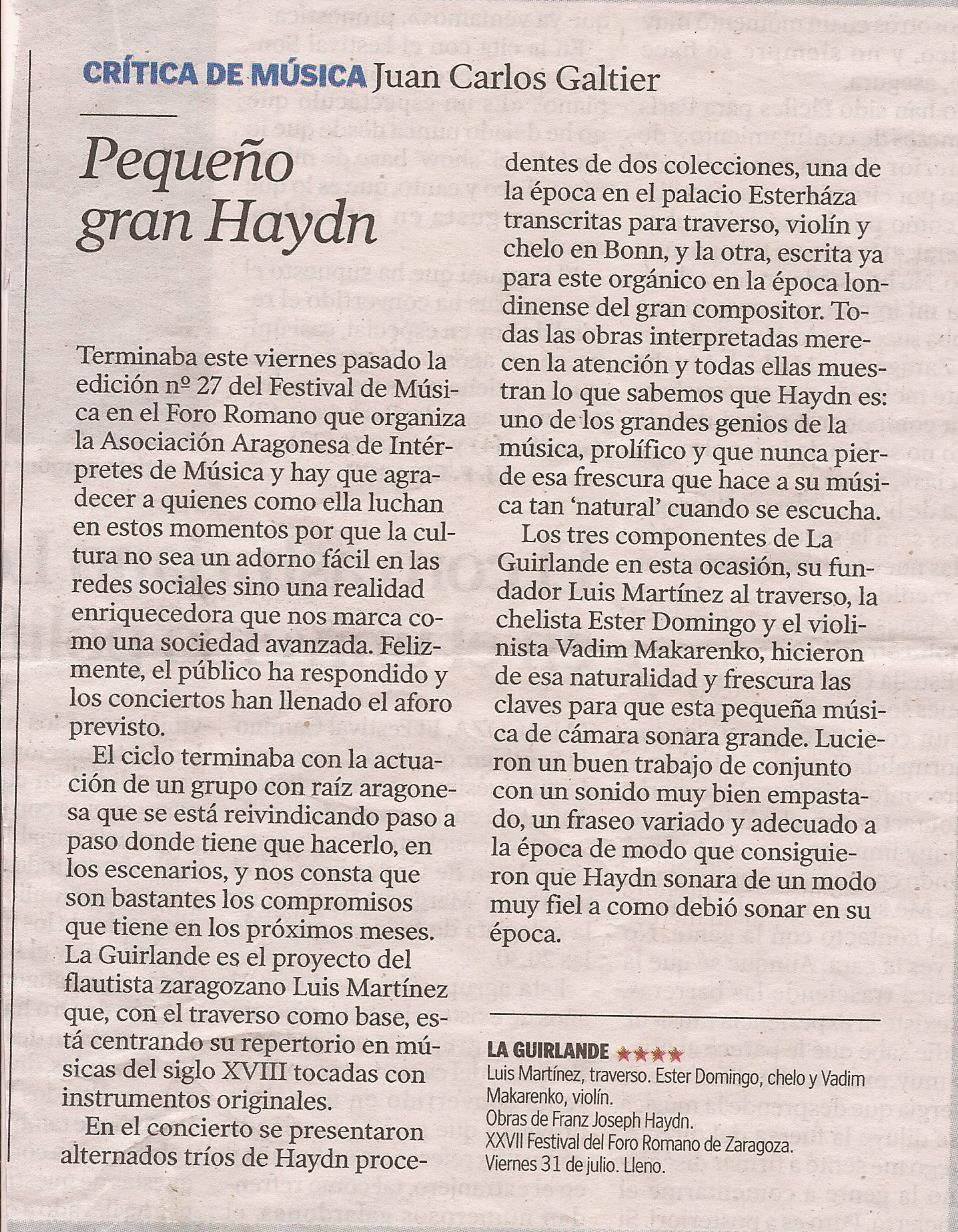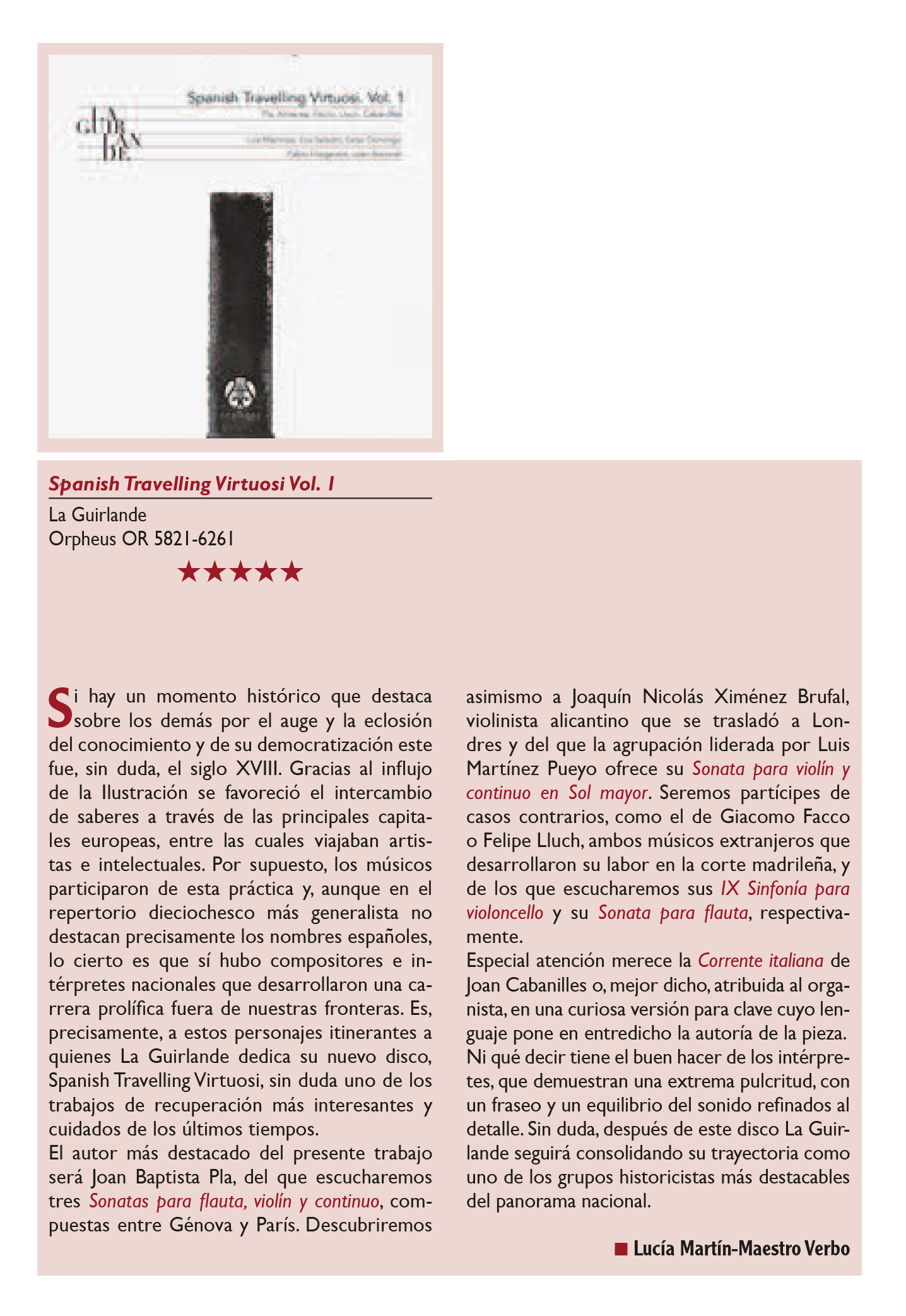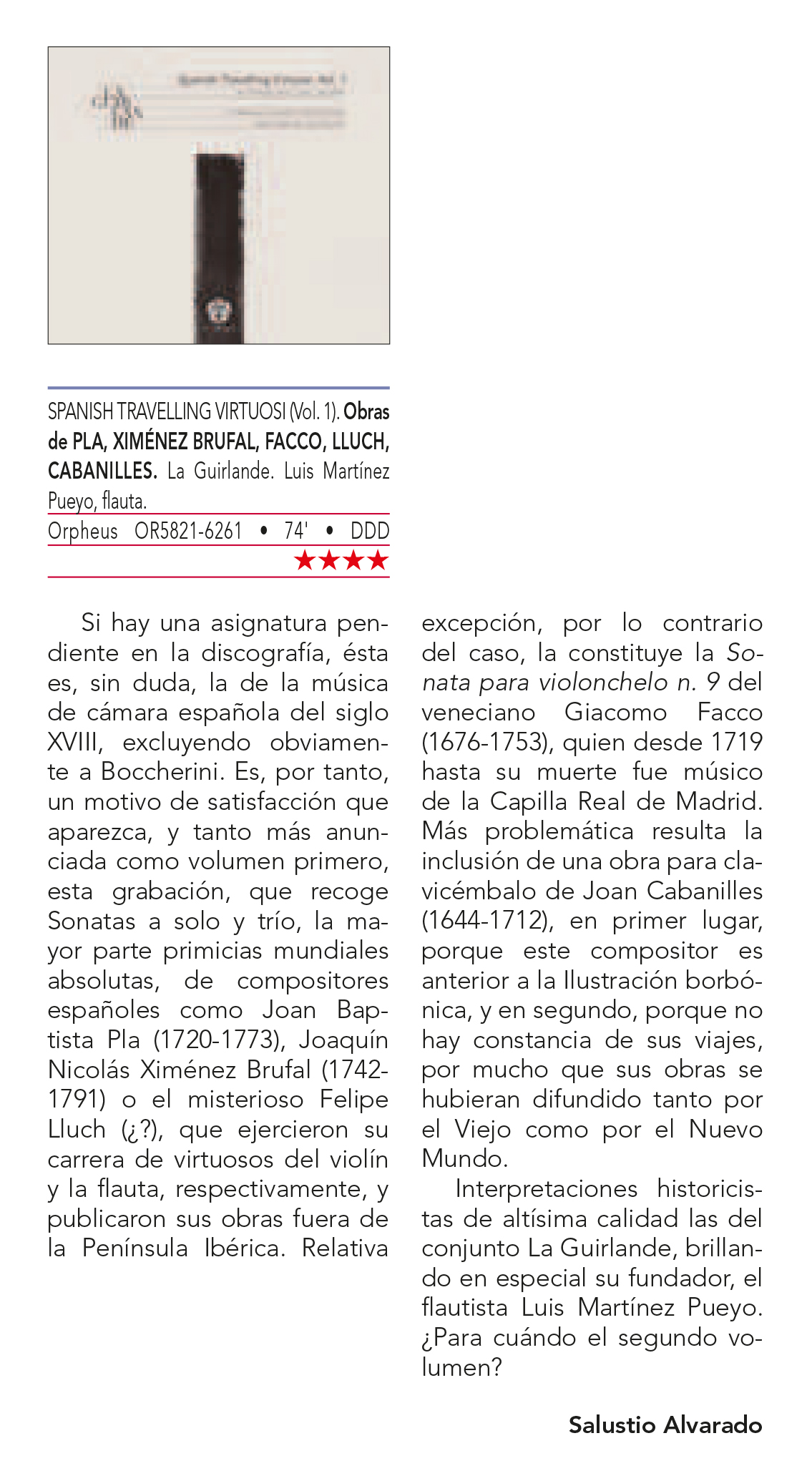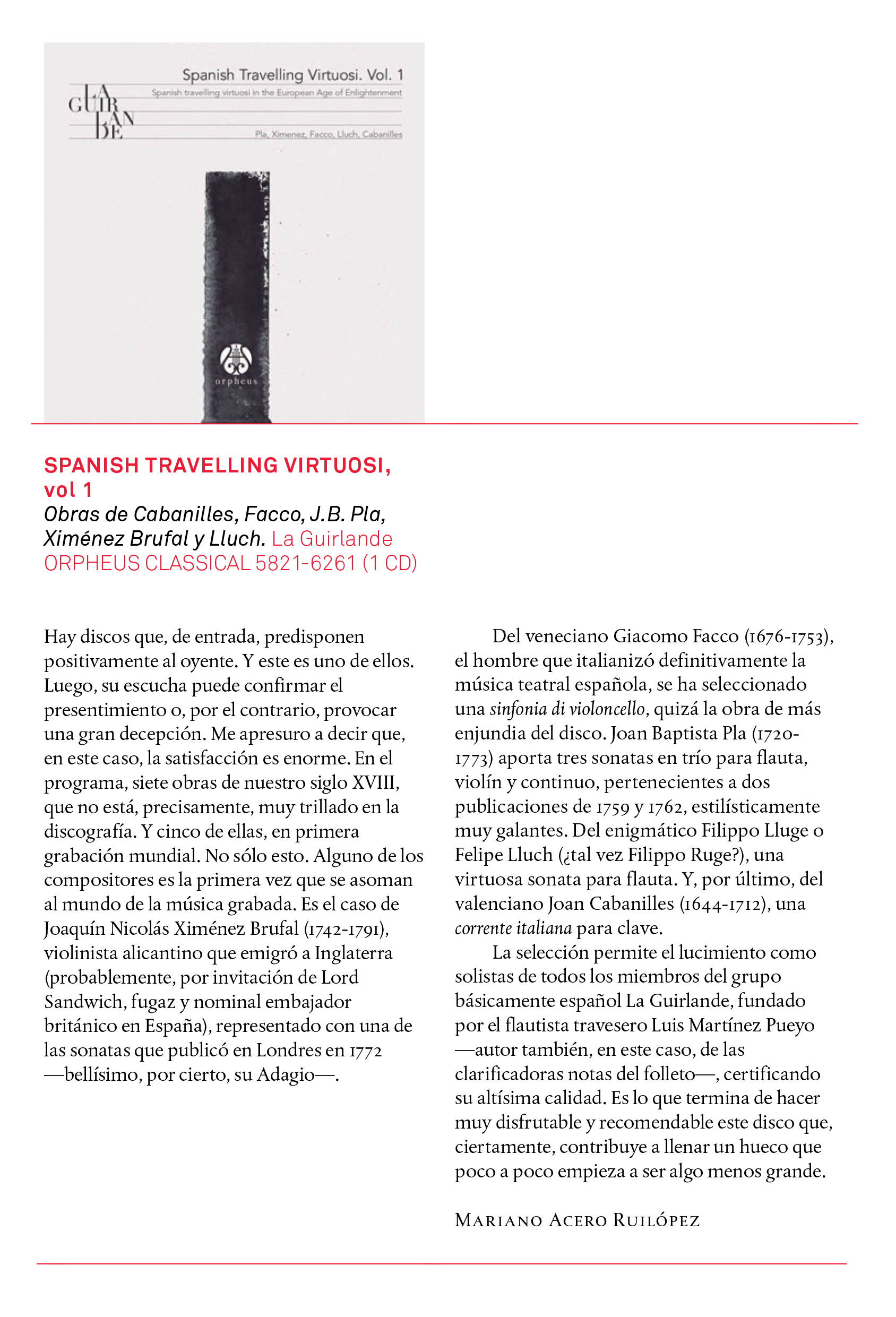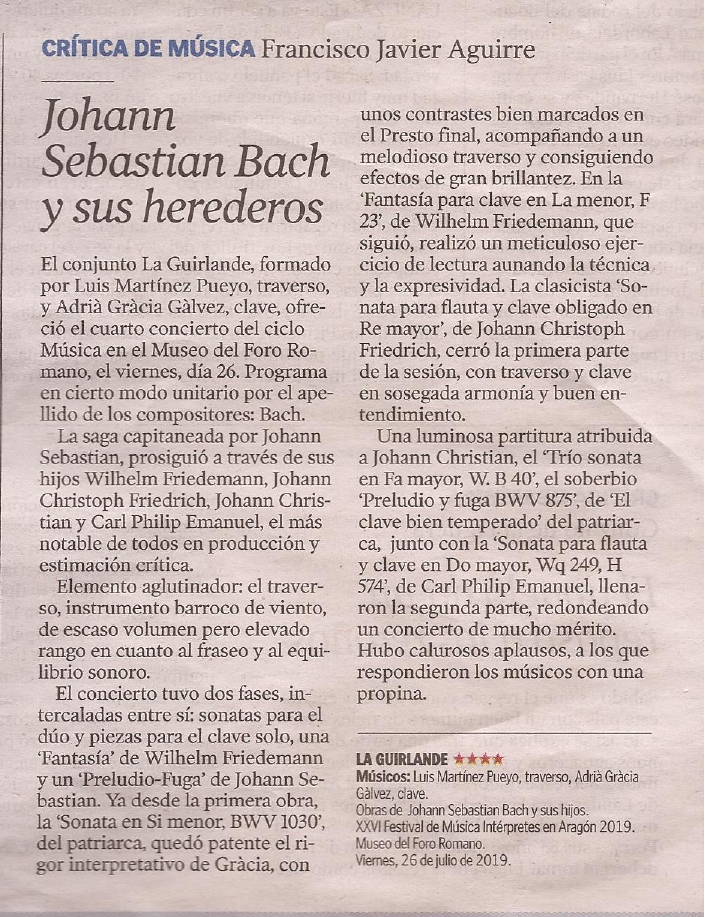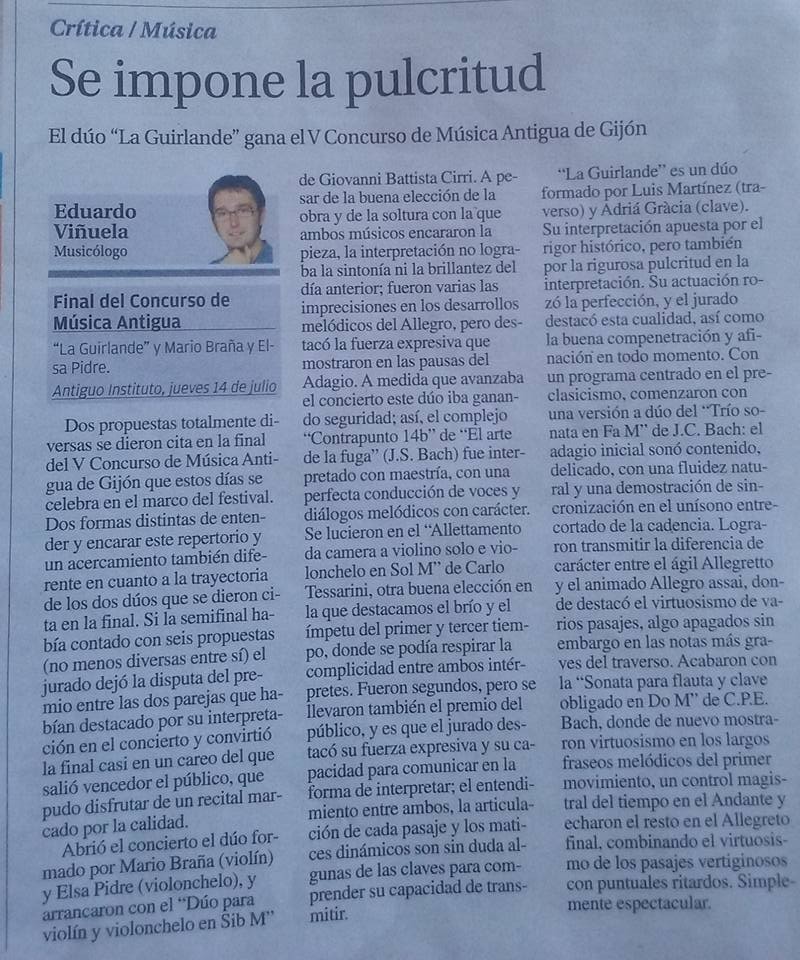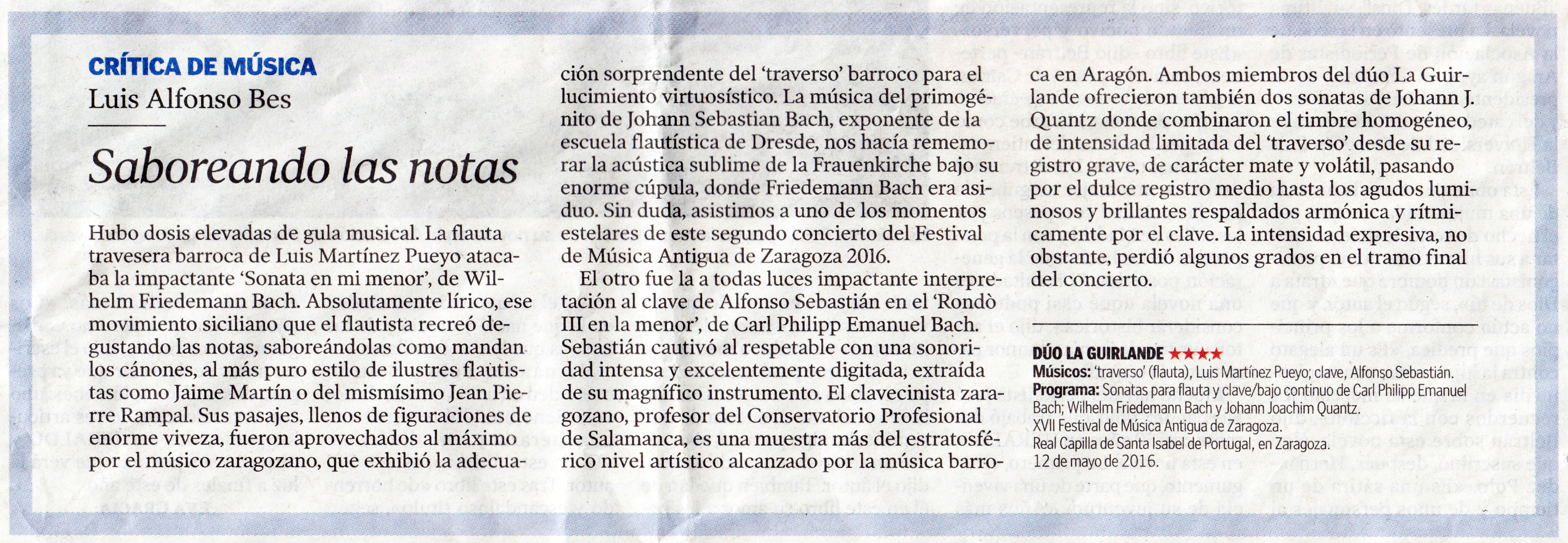PRESS REVIEW
«In collaboration with Ars Hispana, the Aragonese ensemble once again showed its clear commitment to the Spanish musical heritage, in a proposed programme alongside mezzo-soprano Lucía Caihuela that captivated because of both the quality of the chosen repertoire as well as the very vivid and solid performances of those involved.»
«Lucía Caihuela […] continues to show her impressive vocal moment, with a timbre of enormous beauty which has gained a marvellous personality, with a great range in a high register that does not open up and maintains the warmth and coppery colourings of a mid-low register of rich nuances, sustaining an extremely elegant singing line and very careful diction here […]. In the very amorous Aria “Ven, alma mía” there was a beautifully crafted duo with the traverso of Luis Martínez Pueyo – the other great protagonist of the evening and leader of the group – who presented a very neat and organic phrasing and sound, together with a voice full of character in the middle range and with a brilliant, very rested high register. The violin parts were very well shaped in the hands of the extraordinary australian violinist Lathika Vithanage – who possesses an exquisite sound and a rapturous energy – accompanied by the spaniard Sergio Suárez. The continuo was presented with enormous solvency, thanks to four very gifted instrumentalists for these cases: Ester Domingo on baroque cello, Pablo Zapico alternating the archlute and baroque guitar, Silvia Jiménez on baroque double bass and Andrés Alberto Gómez seated at the harpsichord. Excellent here were Domingo’s smoothness and a very richly ornamented archlute. They all elaborated a very expressive B section of the aria, before giving way to a da capo in which the voice presented a very firm and crisp treble, well worked in the duo with the traverso, also showing very fluid agilities.
The Trio sonata I in C major […] began with a Moderato in a very suggestive dynamic approach, exquisitely developing the writing in scales, linking the traverso/violin duo with extreme musicality, a great understanding between the two and with perfect intonation – the presence of the two in the ensemble greatly amplifies the artistic contribution proposed by La Guirlande –. The contribution of a succulent continuo was highlighted in the sound and expression provided by Domingo’s cello. The central Adagio was again built on an outstanding approach to dynamics and a very subtle transfer of motifs between the lines, with the phrasing elaborated here by the traverso standing out. A movement enriched by the very effective details of the continuo members – articulation, ornamentation and richness of timbre –. It concluded with a Tempo di Minuetto in a very intelligent work on the main melodic theme, the homophonic passages being exquisitely elaborated by the traverso/violin duo. Zapico’s continuo on the guitar was undoubtedly a qualitative extra, both for his knowledge of the development of the continuo and for the excellence of his playing.
The recitative “El grosero sayal de su pobreza” was full of vocal warmth, again with very well managed diction and a very firm and refined continuo. The Aria (Spiritoso-Despacio) […], was one of the moments of greatest sonic and emotional impact of the whole evening, especially for the peace and finesse of the Madrid singer’s voice and presence. Sung without traverso, […], the instrumental ensemble managed great balance between the parts and gave the necessary prominence to the voice, which on the other hand offered a da capo of impeccable presence in the lower register, with a limpid and smooth treble, designing some ornamentations that stood out for their enormous taste and singing beauty.
“Aplaudan las ondas”, […], beginning with a very well elaborated recitative on a prosodic level in the voice, an example of singing “on the air” of enormous expression. The Aria (Allegro gustoso) “Del valle al alto monte”, of a more animated character, in which Caihuela defended herself with equal solvency, defining a crisp and energetic coloratura, defending the wide expanse of the aria with firmness […]. The orchestral work shone equally well in an aria of evident musical quality.
Surprising in their quality, they were intelligently defended by Andrés Alberto Gómez, playing both keyboards with dynamic variety, describing the scale passages with care and a sound of notable delicacy in the Adagio, before moving on to a Presto of much more intricate writing, with a marked rhythmic writing very well described here. Great expressive work on the silences, as well as resolving the elaborate passage, of outstanding virtuosity, exceptionally well.
The performance included […] “Yo más no puedo hablar”, Cantada al Santísimo [1768] […] […]. The agilities came comfortably sculpted, supported by some rather agitated violin writing, the strumming on the archlute giving a special colour and character to the continuo. The expressive chromaticism came through well enough, before concluding the aria with a vocal cadenza in which the high register resonated very focused and rounded.
The programme closed with “Respira sin temor”, Cantada a la Purísima Concepción [1750], […], whose Aria (Allegro spiritoso) “Jilguerillos bulliciosos” vibrated with a traverso elaborating the melody with truly delicate phrasing, supported by highly effective violins and a richly ornamented continuo of great constructive solidity. The elegance and brilliance of the voice once again resounded through the huge nave, with enviable intonation care and assured presence. A spectacular vocal performance, supported by a tutti that moves with great comfort in these repertoires.»
Mario Guada on Codalario. March 10 2023
«La Guirlande sounded as good as we have become accustomed to. Once again it featured the Australian violinist [Lathika Vithanage] […] It is a pleasure to listen to her and, above all, to see her play, because she always has a smile on her face. Martínez Pueyo himself was brilliant on the traverso and both in harmony with the rest of the members of the ensemble.
Caihuela showed that peculiar voice of hers, so dark and powerful, and boasted means, confidence and even ease in reaching the highest notes.»
Eduardo Torrico on Scherzo. March 3 2023
«Luis Martinez has chosen pages where his instrument shines as a soloist or blends with Alicia Amo‘s voice, such as the beautiful Cristal bello by Ignacio Jerusalem y Stella, admirably defended by elegant strings and Joan Boronat’s very pertinent continuo on the harpsichord.
Alicia Amo, a soprano with a beautiful presence, defends Jaime Casellas’ religious cantata Inmenso amor with conviction.
This largely unedited anthology is seductive and benefits from a superlative sound recording.»
Philippe Ramin on Classica. April 2022
«Only unreserved praise can be given to soprano Alicia Amo and flautist Luis Martínez. La Guirlande is an indisputable reference in historical performance. Its members are excellent chamber musicians, and their versions are always attractive.
This is a CD that every lover of baroque music and musicological treasures should own and enjoy.»
Antonio Arias on Todo Flauta. March 2022
«We find moments of intense vocal emotion combined with greatly sophisticated instrumental passages of 18th Century Mexico and Spain.
Luis Martinez used his instrument […] with an exceptionally flexible and warm playing, becoming the perfect partner for the soprano Alicia Amo. […] Alicia Amo has an ideal voice for this kind of repertoire, which she masters in a virtuosic manner and with an intelligent, effortless and lively embellishment of the ornamental melodic substance.
The ensemble of six instrumentalists, with both soloists leading, is made up of two violins, cello, lute, double bass and harpsichord, sound in an homogenous way giving meaning to the proposal.
This recording is an exciting discovery for all lovers of Spanish baroque music!»
Wolfgang Reihing on Toccata. January 2022
«In the first work, Cristal Bello, we appreciate a very well-developed coloratura in the melismas, a pleasing vocalization, and ornamentation rich in fantasy. Great theatricality is noticeable throughout the third work, Inmenso amor, […] where Alicia nonchalantly breezes through recitative and arioso, very comfortable in both modes. The sumptuous continuo, very attentive to dynamics, tempo and pauses, stands out in the Allegro. The vocal pearl is to be found in Illana’s Vivaldian aria, Erizada la noche, where legatos of great warmth are recorded in the face of a fierce storm. In Sígueme Pastor, a beautiful duet between soprano and flute seals a sweet, intimate and seamless performance. Boronat at the keyboard shines […] in Nebra’s Sonata de 8º tono, impeccable in articulation and ornamentation. The continuo is outstanding in the fast movements of the Sonata in G minor for flute […], to Martínez’s delight, and in the slow tempos of Versos de segundo tono, where one can appreciate an ensemble breathing very appropriate to the musical rhetoric. To summarise, quality and little to question in a recording that borders on excellence and which, moreover, is a breath of fresh air for the Spanish musical heritage.»
Carlos García Reche on Melómano. November 2021
«It hardly needs to be said that everything on this album deserves special mention. The repertoire […], first of all. And the musicians as well.
The soprano […] Alicia Amo, who performs this forgotten music with emotion and dedication; the harpsichordist Joan Boronat, who unravels a beautiful sonata with a Scarlattian touch by José de Nebra; and Luis Martínez Pueyo, magnificent as a flautist […], extracting from his group, La Guirlande, a round and seamless sound, and unleashing with grit and force a music in which […] he believes. Great album.»
Mariano Acero Ruilópez on Scherzo. November 2021
«La Guirlande, […] created and directed by the flautist Luis Martínez Pueyo, has joined forces with the soprano Alicia Amo in a happy encounter in which they formidably perform music of a very high quality, which deserves to be discovered by every good music lover.
Both the soprano, with her warm voice, which has reached a spectacular maturity that allows her to tackle all kinds of repertoire with a solid technique, good taste and excellent expressiveness, and each and every one of the members of the instrumental group, violins of beautiful and full sound, a basso continuo full of formidable musicians who confer one and a thousand affects to these gallant pieces directly influenced by the Baroque, up to the superb virtuoso flautist who is their enthusiastic conductor, sign an exquisite CD that should be in any self-respecting CD library.»
Simón Andueza on Ritmo. November 2021
«The undersanding between the three performers was totally evident, maintaining an interesting dialogue throughout the whole concert.
Ester Domingo gave a brilliant performance […], standing out for the technique and expressiveness she transmitted during this demanding piece. The harpsichordist was not a mere accompanist and made a great realisation of the bass, complementing the cello to perfection.»
Teresa Pueyo on Diario del Alto Aragón. August 27 2021
«Coherent approach and outstanding performance by La Guirlande, […] efficiently put together by the flutist Luis Martínez.
Vadym Makarenko excelled an exquisite musicality in his performance, elegant as well as consistent.
[…] Ester Domingo […], accompanied by […] Joan Boronat and […] Pablo FitzGerald. A serious piece which the cellist deciphered with great skill.
The turn for the solo flute piece […], a sonata demanding in virtuosity and musical sense, well resolved by Luis Martínez and the ensemble.»
Francisco Javier Aguirre on Heraldo de Aragón. May 16 2021
«Outstanding concert given by the ensemble La Guirlande.
The soprano Alicia Amo, with clear diction, precise articulation, sparkling vibrato and notable expressiveness, took care of the vocal compositions.
[…] “Sonata de 8º tono” for harpsichord, by José de Nebra, performed with harmonious assurance by Joan Boronat.
Luis Martinez […] demonstrated all his skills in the four movements of the piece. Long and refined sonority that of the traverso, well adjusted tempi and good ensemble playing by the trio in the performance of variations and inflextions.»
Francisco Javier Aguirre on Heraldo de Aragón. March 19 2021
«Alicia Amo, […],put forward her extraordinary means and her effortless musicality.
The fresh voice, well placed at all times, homogeneous, easy in the higher register, dramatic in the recitatives, intentional in the expression, of the soprano from Burgos was just one of the elements in these performances of extraordinary balance and of a very high technical and musical level. Interwoven with her voice were the obligato traverso of Luis Martínez, the two violins and a large continuo team that not only gave support to the soloist parts in an elegant, flexible and profound way, but also had juicy interventions, such as Pablo FitzGerald on the archlute in the Versos de segundo tono by Jerusalem and on the guitar in Beninge fac at the end of the concert, or Ester Domingo on the cello in the fast movements of the Sonata by Locatelli, which Martínez performed with total neatness and security. Vadym Makarenko’s relaxed, lyrical and fleshy first violin was also a highlight.
The balance between these four sound levels ensured that the instrumental textures were always transparent. The ensemble shone both in the most delicate and tender parts as well as in the roaring aria by Hernández Illana which have title to the concerts, in which the attacks were more sharp and the contrasts more intense, with ample dynamics. The aria by Iribarren of the encore served only to confirm the excelence of the event.»
Pablo J. Vayón on Diario de Sevilla. March 18 2021
«The performance of his beautiful Sonata in G minor […], which allowed Luis Martínez Pueyo to display his skills, taking the main responsibility in the musical execution of this work with the marvelous collaboration of the harpsichord player Joan Boronat, who assumed his important role as polyphonic unifier with his accompaniment.
The soprano Alicia Amo […] reached that point of dramatism in which the music justified the words and vice versa, showing an expressive tension that captivated the listener, a degree of artistic response that she maintained throughout the programme. In this work, the fine understanding between the rest of the members of La Guirlande was confirmed […]. Each of these players, showing an outstanding expressive individualization, performed this repertoire with spontaneous and at the same time rich collective musicality.»
José Antonio Cantón on Scherzo. December 8 2020
«All three members of La Guirlande, on this ocassion its founder Luis Martínez on the traverso, the cellist Ester Domingo, and the violinist Vadym Makarenko, made of this freshness and naturalness the keys in order to make this small chamber music sound grand. They demonstrated good ensemble work with a unified sound, varied phrasing, adequate for the style, thus achieving a faithfulness to what this music must have sounded like in Haydn’s time.»
Juan Carlos Galtier on Heraldo de Aragón. August 2 2020
«It is precisely to these itinerant characters to whom La Guirlande dedicates their new album, Spanish Travelling Virtuosi, without a doubt one of the most interesting and carefully elaborated projects of musical recovery in the last years.
Needless to say, the good work of the performers, who show extreme skill, with a phrasing and a balance of sound refined down to the detail. Without a doubt, after this album La Guirlande will go on to consolidate its trajectory as one of the most outstanding historicist groups on the national scene.»
Lucía Martín-Maestro Verbo on Melómano. June 3 2020
«The Spanish soprano and ensemble come together in a programme put together by Ars Hispana […] offering pieces […] played at a very high standard.»
«It is an aria of great beauty, performed with a magnificent fluency in the phrasing of the violins of Lathika Vithanage and Aliza Vicente, whose work throughout the concert in the unison passages was outstanding, achieving a remarkable musical rapport. For her part, the soprano from Burgos [Alicia Amo] began by demonstrating a fine diction, [….] with very fitting ornamentation in the aria’s da capo, showing an adequate vocality to the repertoire, of beautiful timbre, with good projection and an interesting elegance in the phrasing. Pablo FitzGerald’s continuo playing on the archlute was magnificent, imaginative and judicious.
Martínez Pueyo’s traverso flowed with powerful effortlessness, with a very clean sound, good air control and an interesting use of articulation. First rate Spanish traverso players are few in number at the present time; he can certainly count himself to be one of them. On her part, Amo offered an intelligent vocal discourse, well adapted to the character and style of the piece, showing a voice that runs well in the high register, sounding natural and in no way forced, in addition to the rather polished enunciation, especially in its medium-low register, which also brought beautiful coloration to the discourse. The two soloists achieved equilibrium between them very succesfully. In the coplas, the continuo finely draws out the rhythmic character of the writing, the baroque guitar ornamenting the continuo in an intelligent manner, accompanying a traverso that neatly profiled the scale passages of the piece.
Especially well accomplished was the balance between the more rhythmically delineated parts with other legato articulated passages, as a well achieved impact with the B part of the aria, showing that contrast with the A part and its da capo, where the violins had already shown an impeccable unison […]. Once again, the lute stood out […] in a continuo of great luminosity and sound impact.
The last of the vocal works […] began with an instrumental introduction of great sound presence, very good balance between the instrumentalists and fine work in the passages in unison, which was followed by the Area – Allegro – resulting in a luminous introduction contrasting the passages to tutti and solo, with some agilities well resolved by the voice. Once again great work in the aria, with a careful diction and a dialogue construction with a beautiful result, as well as a very convincing consistency between contrasting blocks, in which the da capo showed remarkable imagination in the treatment of the voice line, as well as in the outstanding accompaniment.
[…] performed with solvency by Joan Boronat, showing a magnificent agility in the right hand, a very natural phrasing, avoiding any trace of mechanical reading, making intelligent use of the play between the two keyboards in very specific passages, offering a reading quite free agogics and an accomplished contrast between tension and distension of the piece. […] a magnificent version by Vithanage and Vicente, with an exemplary work of unison, taking great care of the sound in order to offer highly refined readings that brought out the very best the compositions. Especially noteworthy was the work offered in one of the pieces, whose development of the canon resource demonstrated a deft work of imitation between the two violins, contrasting with a sobre work in the continuo […] whilst being developed with great imagination […]. Martínez Pueyo surprised the public with polished sound readings, with special regard to his air control and its musicality. He was also brilliant and technically impeccable in the fast movements, accompanied by a soberly constructed continuo, providing a discourse that supports the leading soloist, without trying to provide an intensity of sound that could distort the solo line, but holding it and providing colour.
It was a program […] carried out with an important work by one of Spain’s ensembles with greatest projection and whose work today is among the most interesting. Amo’s contribution added much to a programme of this calibre, as did the playing by the two exceptional violinists. All this supported by a continuo of high level; each of them embracing the other great protagonist of the night, a traverso player who is surely called to do important things.»
Mario Guada on Codalario. March 10 2020
«In-between the vocal pieces […] La Guirlande introduced several instrumental ones: the Sonata de 8º tono by José de Nebra – very scarlattian, wonderfully performed by the harpsichordist Joan Boronat –, some Versos de segundo tono by De Jerusalem – in which the Australian violinist Lathika Vithanage proved why she is considered to be one of the finest specialists on her instrument to have emerged over the last few years, ably supported by her colleague Aliza Vicente – and the Sonata Nº6 op. 2 in G minor for flute and continuo by Pietro Antonio Locatelli, which gave the leader of the ensemble, Luis Martínez Pueyo, a chance to show his skills, always with an admirably produced sound emission, crystalline and refined.
The soprano Alicia Amo sang with the exquisite sweetness that is so characteristic in her, overcoming with little difficulties any problems that came in her way – some of them which were indeed tricky – […]. Both singer and ensemble performed to the very highest level, without the slightest flaw or weakening: both violins were magnificent, the flute was splendid and the basso continuo was sumptuous, comprising the aformentioned Joan Boronat, Ester Domingo – cello – and Pablo FitzGerald – archlute and guitar –.»
Eduardo Torrico on Scherzo. March 6 2020
«Historical performances of the highest quality from the ensemble La Guirlande, especially brilliant was that of its founder, the flute player Luis Martínez Pueyo.»
Salustio Alvarado on Ritmo. February 2020
«All these works are presented with absolute exquisiteness and refinement in the instruments by an ensemble so promising and in such a clear rise as La Guirlande […] Their artistic attributes are not only evident in the technical capacities of their members, […] but in a united feeling of timbre and rhythm, connected to a well maintained sense of phrasing and use of cadences. All the soloists, starting by the flute player himself in the Pla sonatas, Ester Domingo on the cello in the piece by Facco or Joan Boronat in the solo harpsichord piece Corrente italiana by Joan Cabanilles – as well as a splendid accompaniment in the continuo throughout the whole CD – show such self-confidence and assurance and excepcional sound quality.
The album is benefited by a splendid sound recording made at the Palace of the Conde de Aranda in the city of Épila, Zaragoza.»
Germán García Tomás on Opera World. November 21 2019
«I think I fall short in saying it is the best thing I’ve heard this year, a project which brings together the recuperation of works of a more than considerable value, along with a sublime interpretation, simply outstanding […] With this CD, La Guirlande reaffirms itself as one of the ensembles with greatest projection and talent in the current panorama in Europe.
As I said, they have taken special care in the edition, recording, performance, design, repertoire, and worthy of special mention are the wonderful CD notes written also by Luis Martínez – it is marvellous that the performers themselves write the texts of their own recordings – where one can find detailed information on the chosen pieces.
Displaying their excellent domain on the instrument, the performers do not only make their instruments sound, they sing and speak, dialogue, displaying their excellent rhetoric in search of the meaning that so often is lost in nowadays’ performances.
In definitive a “must have” recording in the library of any enthusiast of this fascinating period.»
Pedro Pablo Cámara on Docenotas.com. October 7 2019
«On the CD we are presenting, with an inspired and original theme, the ensemble shows exquisite musicality. Their versions contain historical accuracy and a refined freshness, rediscovering a repertoire both unusual and fascinating. We can only praise this magnificent ensemble, who can be assured of the great career which lies ahead of them.»
Antonio Arias on Todo Flauta. October 2019
Mariano Acero Ruilópez on Scherzo N. 354. September 1 2019
«Already from the first piece, the Sonata in B minor BWV 1030, by the patriarch, Gràcia’s rigorous performance was made clear, with noticeable contrasts in the final Presto, accompanying a melodious traverse and achieving brilliant and sparkling effects. In the Fantasia for harpsichord in A minor F.23, by Wilhelm Friedemann, […] he made a meticulous exercise of interpretation combining both technique and expressiveness. The classicist Sonata for flute and obbligato harpsichord in D Major by Johann Christoph Friederich, closed the first part of the concert, with traverso and harpsichord in peaceful harmony and good understanding between each other.»
Francisco Javier Aguirre on Heraldo de Aragón. July 27 2019
«Am meisten überzeugt zeigte sich die Jury schließlich vom […] Ensemble La Guirlande. Mit ihrem in allen Facetten tief empfundenen, souverän-professionellen, perfekt aufeinander eingespielten Vortrag der Triosonate aus Bachs “Musikalischem Opfer” […]»
«Finally, the panel was most convinced by the […] award winning ensemble La Guirlande […] with their all-around heartfelt, profesionally confindent and perfectly together performance of the trio sonata from Bach’s “Musical Offering” […]»
Heike Haberl on Donaukurier. August 13 2017
«Das […] Ensemble La Guirlande bot ziemlich schwere Kost: Die Triosonate aus Johann Sebastian Bachs “Musikalischem Opfer” ist ein Meisterwerk der Mehrstimmigkeit. La Guirlande schaffte es mit differenzierter Lautstärke und äußerst homogenem Spiel, die Schichten des Werkes freizulegen, und wurde dafür von der Jury mit dem ersten Preis belohnt.»
«The ensemble […] La Guirlande offered a quite difficult part of the repertoire: the triosonata from Johann Sebastian Bach’s “Musical Offering” is a polyphonic master piece. […] La Guirlande accomplished to reveal the underlying layers of this work with their dynamic differentiation and extremely homogeneous performance, and thus the panel has awarded them with the first prize.»
Raphael Beck on Augsburger Allgemeine. August 13 2017
«For the art of magic that is nowadays playing historical music on original instruments, committed performers are needed – devoted, learned, passionate about what they do. That is La Guirlande, a quartet that, with sobriety, elegance and passion had us in tense excitement between the recurrent ellipses in San Marcos church, in the heart of Madrid.
Better impossible!»
Sol Bordas on El arte de la fuga. March 8 2017
«The Spanish chamber music ensemble made its debut with a wonderful programme dedicated to Bach, revealing their exceptional level.»
«The 17th International Sacred Arts Festival goes on in its present edition, this time with one of the most impactful concerts I remember in these last times of an almost completely Spanish historicist ensemble. La Guirlande made their debut in this edition of the Sacred Arts Festival to bring to the public […] this wonderful programme intelligently titled “In the name of the Father”.
La Guirlande’s performance was as surprising as it was overwhelming. […] The most visible head of the group is that of Luis Martinez, traverso performer who studied in the Schola Cantorum Basiliensis and is undoubtedly amongst the best players of this instrument in this country. […] He was brilliant, both in technical and expressive terms, without any superficial displays, keeping a dialogue when the piece asks for it and showing his virtuosity in the solo sonata. […] Alfonso Sebastián […] There are few performers in this country with the knowledge he possesses about Bach’s work. His profound knowledge, both from the keyboard […] as from theory is remarkable, and he therefore always contributes with an extra point to the ensemble with which he is collaborating. His versions are always refined, subtle, full of intelligence, with substantial rhetoric weight. And what can we say about his solo interventions. What we saw yesterday […] was world-class level harpsichord playing.
[…] Lathika Vithanage […] Impressive technique and sound coming from her violin in every moment. Her vision of Triosonata BWV 1038 was colossal […] as well as that of BWV 1079, and brilliant in her sonata for violin and obligato harpsichord. Her ability to move emotions with her medium-low register was colossal. […] Her fragile appearance is opposed to her extreme ability. Very few times have I seen a violinist flow in such a natural and apparently simple way while playing Bach. It is a pleasure to watch her enjoy herself in such an honest way, so obviously projecting her feeling outwards. Ester Domingo proved herself a highly skilled cellist, holding most of the discourse of the pieces. […] she was able to hold the tension and was during most of the concert at the really high level of her colleagues.
In short, a concert at a very high level […]. A wonderful example of teamwork, in which one could appreciate the serious and detailed work, achieving […] a first-class performance for the audience, second to none of the great ensembles of the current music scene.»
Mario Guada on Codalario. March 7 2017
«Vithanage impressed for her technical skills and her elegance when playing, always accompanied by a wide smile that showed how much she was enjoying […] the music and the performance – her own and her colleagues’ –. Martínez’s sound was clear and warm, very warm, especially in that overwhelming Andante of Sonata 1034. Domingo was splendid both in continuo work and the main parts each of the four performers have in the Offer. And Sebastián was able to extract all substance from the beautiful sound of the Grimaldi harpsichord […] opposite him and on which he played a memorable version of the Prelude, Fugue and Allegro.
After listening to Bach played by such qualified hands, one has a feeling of reconciliation with the world. If it only were more than a feeling.»
Eduardo Torrico on Scherzo. March 6 2017
Eduardo Viñuela on La Nueva España. July 16 2016
Eduardo Viñuela on La Nueva España. July 15 2016
«Absolutely lyrical, the Sicilian movement that the flautist Luis Martinez Pueyo recreated, savoured all the notes, playing them as in the style of famous flutists such as Jaime Martin or Jean-Pierre Rampal himself. The passages, full of figurations of enormous vivacity, were used at the highest level by the musician from Zaragoza, who exhibited the surprising adaptation of baroque traverso for virtuosistic brilliance.
Sebastian wowed the public with an intense sonority and excellent fingering, extracted from his magnificent instrument. The harpsichordist from Zaragoza […] is one more example of the stratospheric artistic level reached by Baroque musicians of Aragon.»
Luis Alfonso Bes on Heraldo de Aragón. May 12 2016
«Virtuos und zugleich feinfühlig interpretierte Luis Martinez Pueyo auf der Traversflöte die Solostücke in den Flötensuiten von Jacques-Martin Hotteterre.»
«Luis Martínez Pueyo performed both virtuously and gently with his traverso the pieces of the flute suite by Jacques-Martin Hotteterre.»
Hans Jürgen Kugler on Badische Zeitung. February 25 2015
